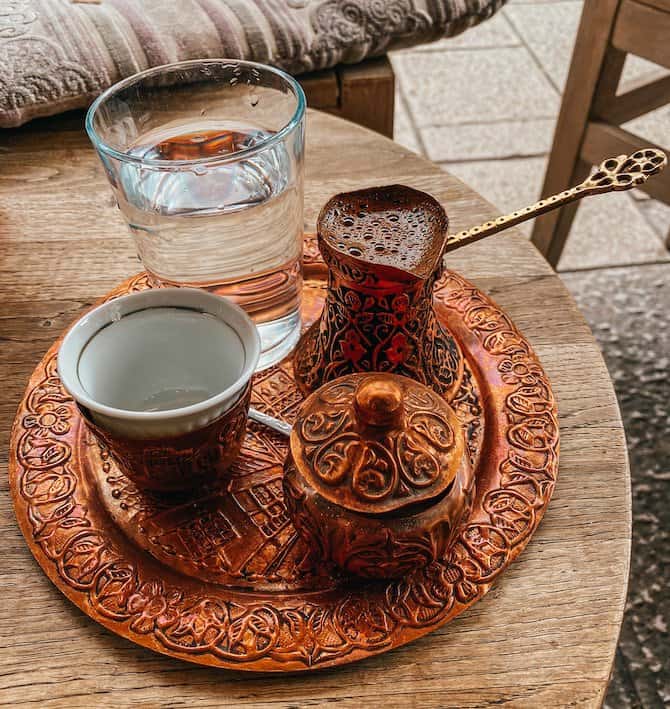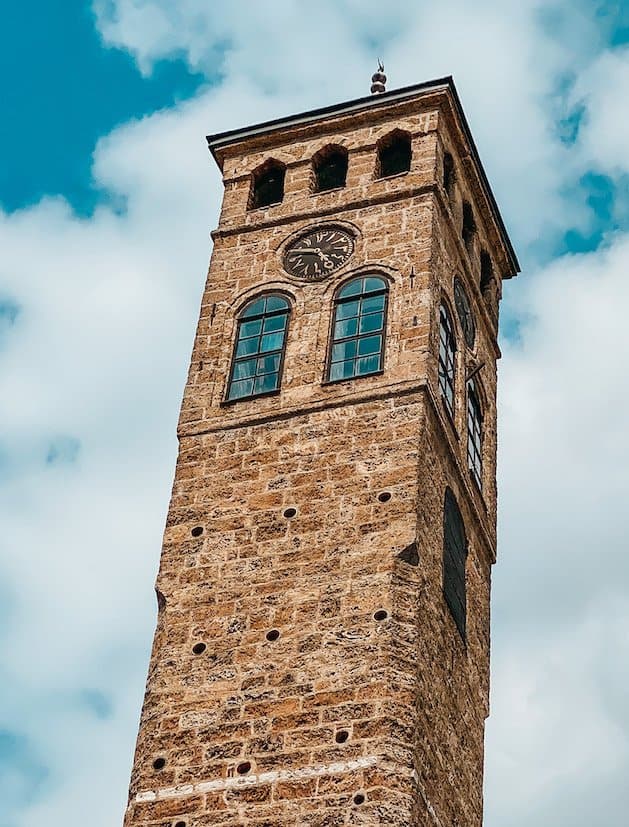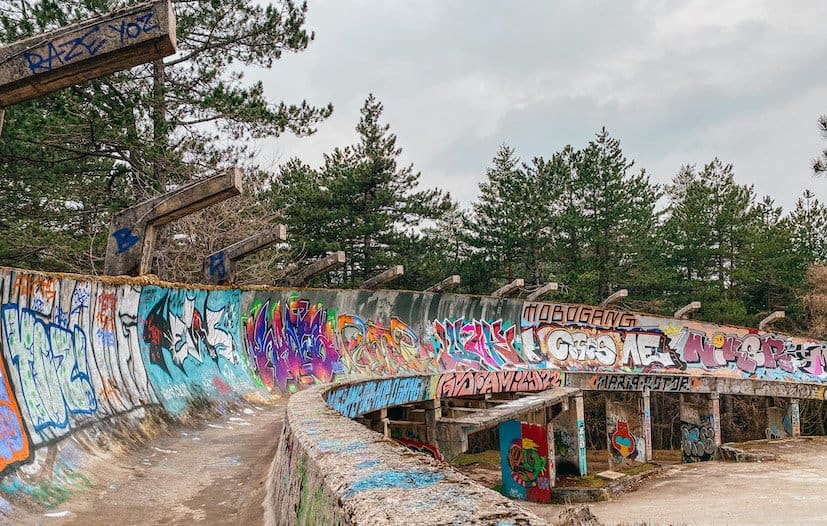Veganderlust contains affiliate links and is a member of the Amazon Services LLC Associates Program. If you make a purchase using one of these Amazon links, I may receive compensation at no extra cost to you. For more info, see the Disclosure Policy.
17 Best Things to Do in Sarajevo
Sarajevo, the capital city of Bosnia and Herzegovina, is a vibrant city full of different cultures. The city in the heart of the Balkans has a rich history and even shaped world history more than once.
There are more than enough things to do in Sarajevo to discover the city’s history and enjoy the lively vibes of today.
I spent 2 weeks in Sarajevo and used this time to explore as much as possible from this beautiful city and its surroundings.
Walking through the city you can see the influence of different empires, like the Ottoman Empire or the Austro-Hungarian Empire. You also notice the more recent history, like the Bosnian War which only ended in 1995.
The capital of Bosnia Herzegovina has emerged as a resilient and dynamic city, one that is home to a thriving arts and culture scene and welcoming locals. And most of the best things to do in Sarajevo are free.
Visit the place where world history was shaped
1. Latin Bridge
Right next to the Latin Bridge world history was shaped. On 28 June 1914 the heir to the Austro-Hungarian Empire, Franz Ferdinand, and his wife Sofia were assassinated. This led to the beginning of the First World War.
Visiting this history-changing location should be on everyone’s Sarajevo itinerary.
🇧🇦 Visit the Latin Bridge and learn about its history on a walking tour
At the corner of the building, you can see the footsteps where the assassin, Gavrilo Princip, stood when he shot Archduke Franz Ferdinand of Austria. This was not the first attempt on the Archdukes life, just hours before the assassination he escaped a bomb explosion.
Don’t miss out on having a look at the bridge itself either though, it’s the oldest stone bridge from all the stone bridges crossing the river.
Learn about the Bosnian War
The Bosnian War and the events leading up to it are very complicated and I can’t go into detail here. I just want to give a very rough outline.
Bosnia and Herzegovina used to be part of Yugoslavia and there have always been three ethnic groups living in Bosnia and Herzegovina, the Bosniaks (Bosnian Muslim), Serbs and Croats.
Along with Croatia and Slovenia, Bosnia and Herzegovina wanted to proclaim independence. The Bosnian Serbs, however, didn’t want Independence from Yugoslavia. Soon after the war broke out.
🇧🇦 This tour is a great way to learn more about Sarajevo’s history
You can learn a lot about the Bosnian War in Sarajevo by visiting museums, doing a guided walking tour which usually has guides who actually lived through the war and reading up on it.
I found this YouTube video very helpful to get a better overview:
2. Keep a look out for bullet holes
The Bosnian war only ended in 1995 and Bosnia’s capital Sarajevo was under siege from 1992 to 1996. The siege of Sarajevo was the longest siege of a city in modern warfare and you can still see the results in the city today.
Just keep an eye out and look at the buildings surrounding you. Many buildings are still riddled with bullet holes.

The most dangerous streets during the siege was the main street leading into the city, which consists of the two boulevards, Ulica Zmaja od Bosne and Meša Selimović Boulevard.
There are many tall buildings on these streets and snipers hid there and shot at everyone moving. That’s why the streets got the nickname, Sniper Alley.
Learn about the tragic history of Sarajevo on this Sarajevo Roses tour
3. Remember the victims at Sarajevo Roses
During the siege of Sarajevo, many people were killed by bombshells. Those mortar shells also left a scar on the concrete. To remember the victims they left concrete scars on the ground and painted them red whenever at least 3 people were killed at a location.
The painted concrete scars kind of look like flowers, so they were called Sarajevo Roses.
There are many Sarajevo Roses all over the city, an easy one to find in the city centre is in front of the Sacred Heart Cathedral.
Learn about the tragic history of Sarajevo on this Sarajevo Roses tour
4. Museum of crimes against humanity and genocide
The museum of crimes against humanity and genocide is a great place to learn about the atrocities of the Bosnian War. The worst genocide on European soil since the Second World War was committed in Bosnia and Herzegovina during the 1990s. In the museum, you hear and read about real stories from the victims.
The museum is very depressing, it’s not for the faint of heart, but it’s important to not forget all the victims of the war. And don’t forget that the war happened only about 30 years ago, so many people you meet in Sarajevo have actually lived through this time.
5. Tunnel of Hope
The Tunnel of Hope is known under many other names as well, like War Tunnel, Tunnel of Life or just Sarajevo Tunnel. It’s located near the airport, you can only get there by taxi or through an organised tour, there’s no public transport going there.
The underground tunnel was constructed during the siege of Sarajevo. During this longest siege of modern warfare, the tunnel was the only way to get food and weapons into the surrounded city.
Today the tunnel is one of the most visited and best museums in Sarajevo.
🤩 I love this tour of Yugoslavia’s fall for including transport to the Tunnel of Life
6. Free walking tour
The best way to learn about the history of Sarajevo and the Bosnian War is with a free walking tour. I did a great walking tour with Meet Bosnia. The local guide, Edin, is very knowledgeable and even tells stories from his childhood during the siege of Sarajevo.
In many other cities, the guides from walking tours are not from the city themselves, not so in Sarajevo. The local guide made the free walking tour one of the best things to do Sarajevo has to offer.
A free walking tour is a perfect way to get an overview of Bosnian history. If you want to learn more about the country’s history there are some great tours which give you a more detailed understanding of history:
If you want to learn more about Sarajevo’s recent history, check out this Fall of Yugoslavia tour.
Sarajevo as meeting point for different religions
Even though religion has been part of the conflict in the past, nowadays you find people with different religions living together in peace in Sarajevo. So visiting different religious houses in very close proximity is one of the things to do in Sarajevo.
7. Sacred Heart Cathedral
The Sacred Heart Cathedral or just Sarajevo Cathedral is the most important catholic church in Sarajevo. It’s also the largest cathedral in Bosnia and Herzegovina and the seat of the archbishop.
In front of the cathedral is a statue of Pope John Paul II, he visited the city twice and his successor Pope Francis visited the city once. Pope John Paul II requested for the bullet holes to be left in the church facade as a reminder of the war.
🤩 I love this walking tour for visiting all the best spots in Sarajevo’s old town
8. The old synagogue in Sarajevo
The oldest synagogue in Sarajevo was built in 1581. Over the years it was destroyed multiple times but always rebuilt by the Jewish community. Today it’s not a synagogue anymore but a museum about the history of the Jews in Bosnia and Herzegovina.
Next door to the oldest synagogue in Sarajevo is the new synagogue which functions as an art gallery. The only functioning synagogue is the Sarajevo Synagogue on the south side of the Miljacka River.
In the National Museum of Bosnia and Herzegovina, you can find an important historic Jewish text, the Sarajevo Haggadah. It’s one of the oldest Sephardic Haggadahs in the world and it’s a UNESCO Memory of the World.
A Sephardic Haggadah is an illustrated manuscript from the Hispanic Jews about the biblical escape of the Jewish people from slavery in Egypt.
The National Museum of Bosnia and Herzegovina and the new synagogue were both designed by Czech architect Karel Pařík.
🤩 I love this walking tour for visiting all the best spots in Sarajevo’s old town
9. Gazi Husrev-beg mosque
The Gazi Husrev-beg mosque is one of the best examples of architecture from the Ottoman rule in the Balkans. It’s also the largest historical mosque in Bosnia and Herzegovina and the central Sarajevo mosque.
However, it’s not the first mosque built in Sarajevo. The oldest mosque is the Emperor’s Mosque.
During the siege of Sarajevo, the mosque was heavily damaged but it was reconstructed right after the war in 1996.
Today the mosque undoubtedly shapes the landscape of Sarajevo. The mosque with its minaret is visible from all over the old town of Sarajevo. And right next to the mosque is the famous bell tower, more on that in a second.
🤩 I love this walking tour for visiting all the best spots in Sarajevo’s old town
Enjoy the Sarajevo’s old town
Learning about the Bosnian War and visiting places where people were killed is very depressing. But when you walk through the narrow streets of old town Sarajevo and watch the hustle and bustle on popular squares it’s easy to forget about it.
There are plenty of amazing things to see in Sarajevo’s old town.
After my time in Bosnia, I visited Serbia and there I missed the cute old town charm of Sarajevo.
10. Try to read the time at the clock tower
The clock tower in old town Sarajevo shapes the skyline of Sarajevo just as much as the adjacent Gazi Husrev-beg mosque.
The most fascinating part of the clock tower is the clock itself. It’s the only public clock tower in the world with lunar time. The clock’s hand points to 12 exactly at sunset.
🤩 I love this walking tour for visiting all the best spots in Sarajevo’s old town
11. Visit the market: Gazi Husrev-begov bezistan
The Gazi Husrev-beg’s bezistan is the best-preserved bazaar in Sarajevo from the Ottoman period. It used to be an indoor silk market, nowadays the old bazaar is mainly a souvenir market.
Even if you’re not in the mood to buy souvenirs, checking out the architecture of the indoor market alone makes it one of the best Sarajevo things to do.
🤩 I love this walking tour for visiting all the best spots in Sarajevo’s old town
12. Feed the pigeons at Sebilj fountain
The Sebilj in Sarajevo is a wooden fountain from the Ottoman period in the middle of the Baščaršija square. A local legend says that people who drink from this fountain will come back to the city someday.
So if you want to come back to Sarajevo, make sure to add drinking from Sebilj on your things to do in Sarajevo list.
The square is not just famous for the fountain but also for the number of pigeons that live there. You can even buy some kernel there to feed the pigeons and take pictures. The seeds are sold in plastic containers but you can return them after you’re done feeding the pigeons.
🤩 I love this walking tour for visiting all the best spots in Sarajevo’s old town
13. Marvel at city hall
Sarajevo city hall or Vijećnica as its also called is the best example of architecture from the Austro-Hungarian period. The building only opened up again in 2014 after reconstruction from the damage of the war. Today it houses the mayor’s office and the Sarajevo city council.
The best view of the city hall is from the other side of the Miljacka River. On this side of the river, you can also get a great picture with the Sarajevo sign in front of the iconic city hall.
🤩 I love this walking tour for visiting all the best spots in Sarajevo’s old town
14. Have some Bosnian coffee Tea house

In the old town of Sarajevo, you can find countless tea houses which sell Turkish tea and Bosnian coffee. Bosnian coffee is a very strong black coffee with sugar.
The coffee is served in a small metal pot and you have to slowly pour it into your cup. Pouring it slowly is very essential because the coffee powder is still inside the pot and if you pour it too fast it will be poured into your cup.
Tip: There are also a few amazing all-vegan restaurants in Sarajevo.
Venture a little bit outside the city center
There are a lot of places to visit in Sarajevo in the old town but if you venture just a little bit outside you’ll be rewarded with more great things to do in Sarajevo.
15. Yellow bastion
The yellow bastion, yellow fortress or Žuta Tabija is a canon fortress which served as a defence against the Austro-Hungarian Empire. Over the years it got destroyed and rebuild many times.
Today the yellow fortress is one of the best Sarajevo viewpoints. After just a short uphill walk you get a beautiful view of Sarajevo center. Enjoying the view of the city from above is one of the top things to do in Sarajevo.
During Ramadan the small canon is fired every day at sunset. It’s a popular spot for the Muslim community. Everyone brings their own food and they enjoy the breaking of the fast together after sunset.
🤩 Learn about the city’s history while overlooking the old town
16. Brewery
If you love beer you should not miss the Sarajevo brewery. The Sarajevo brewery or Sarajevska pivara was the first local industry which opened in 1864. It soon became one of the leading producers in Bosnia and Herzegovina.

During the siege of Sarajevo the brewery was the only place where civilians could get water from. Nowadays it’s still a brewery but also a museum.
17. Olympic park
In 1984 the Winter Olympics were held in Sarajevo. Only 8 years later the war broke out and most Olympic facilities got destroyed. Some have been renovated and some are still abandoned.
The most well known abandoned site it the Bobsleigh and Luge Track. During the siege of Sarajevo the bobsleigh track was used as an artillery position by Bosnian Serbs surrounding the city.
Nowadays you can explore the abandoned bobsleigh track which became famous for its graffiti.
The best way to get there is to take the cable car to the hilltop. I would recommend getting a return ticket for the funicular because the walk down is very steep and very long, I speak from experience.
🤩 I love this Sarajevo tour for including a trip to the abandoned bobsled track
From the hilltop, you have a great view and going down an abandoned bobsleigh track is definitely one of the most unique Sarajevo attractions.
Day trips from Sarajevo
The most popular day trip from Sarajevo is to Mostar. If you do this day trip with a tour as I did, you can not just visit the famous old town of Mostar but also some of the beautiful nature Bosnia and Herzegovina has to offer.
And when you stroll through the old streets of Mostar and take it the city’s charm, you’ll understand why it’s Bosnia’s second most visited city. There are quite a few things to do in Mostar but you can fit the best things into a day trip.
🤩 This is the day tour from Sarajevo to Mostar I did and I loved it!
Another very interesting day trip is to Srebrenica, where you can learn more about the former Yugoslavia and the horrible massacre that happened there.
FAQ about things to do in Sarajevo
Is Sarajevo good for tourists?
Sarajevo is a great place for tourists. It’s not overrun by tourists but there are many things to do in Sarajevo Bosnia and Herzegovina. Bosnia’s capital is the meeting point of the East and the West and offers the best from both.
What to do when in Sarajevo?
There are many things to do in Sarajevo, from visiting locations which changed world history, over learning more about the Bosnian War, to discovering the diverse religious landscape of the city and to immerse yourself in the charming old town with its many tea houses.
What is Sarajevo best known for?
Sarajevo is best known for the assassination of Archduke Franz Ferdinand which started the First World War and the siege of Sarajevo during the Bosnian War. The city has much more to offer than those brutal historic events.
How many days in Sarajevo is enough?
It’s best to spend about two full days in Sarajevo in order to do all the things to do in Sarajevo.
Can you drink tap water in Sarajevo?
Tap water in Sarajevo is safe to drink and it’s actually really nice compared to other holiday destinations.
Do I need cash in Sarajevo?
Most bigger restaurants accept card but it’s still recommended to have cash with you in Sarajevo since many smaller restaurants and museums don’t take card. The currency in Sarajevo is the Bosnia and Herzegovina Convertible Mark.
Is Sarajevo a walkable city?
Sarajevo is a very walkable city. The only two sights not in walking distance are the Sarajevo Tunnel and the abandoned bobsleigh track.
Why Sarajevo is called Jerusalem?
Sarajevo is sometimes called the Jerusalem of Europe because of its long history of religious diversity. You can find a mosque, a synagogue, a catholic church and an orthodox church within a short walk from each other.
Is Sarajevo an expensive city?
Sarajevo is one of the cheapest European capitals. You can easily get a meal for about € 5.
Can I use euro in Bosnia?
The official currency of Bosnia and Herzegovina is the Bosnia and Herzegovina Convertible Mark. You cannot use euros in Bosnia and Herzegovina.
Is Bosnia cheap or expensive?
Bosnia and Herzegovina is one of the cheapest countries in Europe and even though Sarajevo is more expensive than the countryside it’s still very cheap compared to other European capitals.
Is Bosnia landlocked?
Bosnia and Herzegovina is not landlocked, it has the second smallest coastline in the world.
Where is Sarajevo?
Sarajevo is the capital of Bosnia and Herzegovina, a country in the Balkans. The country is neighbours to Croatia, Serbia and Montenegro.
What country is Sarajevo in?
Sarajevo is the capital city of Bosnia and Herzegovina.
Final thoughts: Is Sarajevo worth visiting?
I’ll be honest before going to Sarajevo I didn’t know much about the city or the whole country. And once I was there I was pleasantly surprised.
I really liked the old town charm and the combination of Western and Eastern culture. And on my day trip to Mostar, I got a glimpse into how beautiful the landscape of Bosnia Herzegovina is.
Read more about Bosnia and Herzegovina:
- 17 Best Things to Do in Sarajevo
- Unforgettable Day Trip to Mostar from Sarajevo
- All You Need to Know About Sarajevo Abandoned Bobsled Track
- Best Vegan Food Sarajevo and Where to Find It
- Amazing Attractions and Best Things to Do in Mostar
- Is Bosnia Landlocked? Almost But Not Quite
- Bosnia and Herzegovina
- Best Ways to Get From Sarajevo to Belgrade
- Balkan Capital Cities: Which One Is Right For Your Next Holiday?
Pin it for later:




















